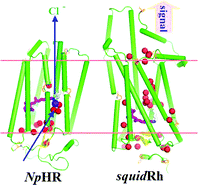Structural divergence and functional versatility of the rhodopsin superfamily†
Abstract
Seven-transmembrane-helix

- This article is part of the themed collection: Photosensitive retinal pigments
* Corresponding authors
a
Department of Physics, Graduate School of Science, Nagoya University, Nagoya, Japan
E-mail:
kouyama@bio.phys.nagoya-u.ac.jp
Fax: +81-52-789-2436
Tel: +81-52-789-5108
Seven-transmembrane-helix

 Please wait while we load your content...
Something went wrong. Try again?
Please wait while we load your content...
Something went wrong. Try again?
T. Kouyama and M. Murakami, Photochem. Photobiol. Sci., 2010, 9, 1458 DOI: 10.1039/C0PP00236D
To request permission to reproduce material from this article, please go to the Copyright Clearance Center request page.
If you are an author contributing to an RSC publication, you do not need to request permission provided correct acknowledgement is given.
If you are the author of this article, you do not need to request permission to reproduce figures and diagrams provided correct acknowledgement is given. If you want to reproduce the whole article in a third-party publication (excluding your thesis/dissertation for which permission is not required) please go to the Copyright Clearance Center request page.
Read more about how to correctly acknowledge RSC content.
 Fetching data from CrossRef.
Fetching data from CrossRef.
This may take some time to load.
Loading related content
